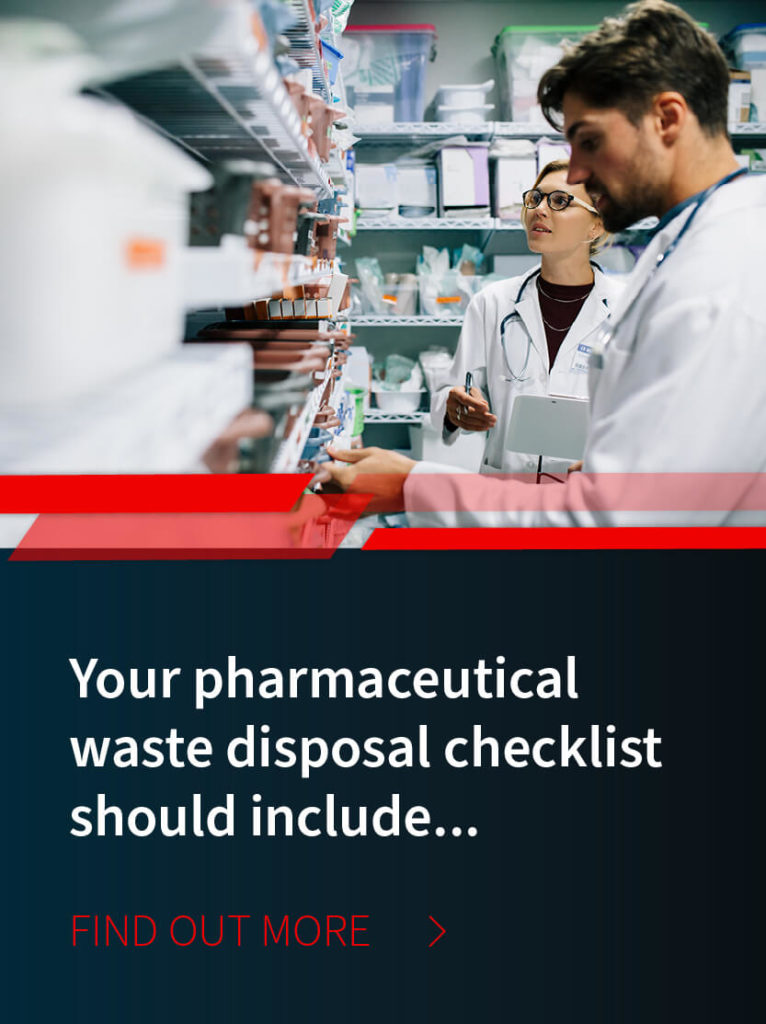
ARE YOU MANAGING YOUR PHARMACEUTICAL WASTE DISPOSAL LEGALLY?
A pharmaceutical waste must be properly identified, segregated, and managed to meet the dictates of the EPA—and particularly so if it’s considered to be a hazardous waste.
Classification parameters for pharmaceutical waste disposal
There are two kinds of hazardous waste according to the EPA: (1) Characteristic and (2) Listed.
- Characteristic hazardous wastes possess noxious “characteristics” such as:
- Flammability—they catch fire under certain conditions, posing obvious transport & storage dangers
- Corrosiveness—they can disintegrate metals and therefore require storage vessels constructed of (or lined with) anticorrosive materials
- Instability—they’re prone to explode under heat or pressure; or produce toxic fumes, gasses, or vapors
- Toxicity—they are harmful or fatal to humans and/or local biota when ingested or absorbed, or can leach into soil or groundwater
- Reactivity—otherwise benign chemicals might become flammable, corrosive, unstable, or toxic when mixed with others
- Listed hazardous wastes don’t have such intrinsically noxious “characteristics” in and of themselves. Instead, they require hazardous waste disposal because they’re offshoots of manufacturing practices that typically produce a hazardous waste.
The EPA keeps two lists of these chemicals, all of them considered a hazardous waste in both their pure and commercial-grade formulations. These are the “P” and “U” lists and contain such everyday meds as warfarin, cyclophosphamide, and lindane.
In sum, even though a pharmaceutical waste might not exhibit a “characteristic” such as ignitability or toxicity, it still might be a P- or U-listed chemical. Thereby, it will require hazardous waste management when it comes time to dispose of it.
Beware of EPA “creeping specs”
Some pharmaceuticals that escape the EPA’s technical definition of a hazardous waste might anyway be dangerous to dispose of carelessly, thereby making hazardous waste management prudent for avoiding any unexpected liabilities. Among them:
- Formulations containing P- or U-listed drugs
- Chemotherapy agents not already listed as RCRA hazardous
- Vitamin or mineral preparations containing selenium or cadmium
New rules for “sewering”
The EPA announced new rules—effective last August—for managing pharmaceutical waste disposal. They represent an effort to restructure disposal requirements, making them better applicable to the unique attributes of healthcare enterprises, “while maintaining protection of human health and the environment.”
However, it’s important to be aware that along with streamlining applicable standards, the new rules also intend to reduce the amount of pharmaceutical waste entering America’s waterways to about 60 percent of current levels—from about 3,900 tons yearly to roughly 2,300 tons—and it does so by prohibiting the “sewering” of any hazardous waste pharmaceutical.
That means if you’re the manager of a hospital, clinic, pharmacy, or pharmaceutical manufacturing company, much of what you might be accustomed to pouring literally “down the drain” (prior to last August) might lately require hazardous waste management, under penalty of federal law, making it imperative to get expert advice, lest you garner the unwanted attention of the EPA.
Peripheral wastes might also require careful pharmaceutical waste disposal
The need for hazardous waste management isn’t limited to pharmaceuticals. Any vials, bags, or PPE exhibiting trace quantities of “characteristic” or “listed” substances also require hazardous waste disposal, as do spilt liquids or pills—and even packaging.
Personnel training issues for pharmaceutical waste disposal
As chemical wastes tend to compound their noxious characteristics when mixed (see reactivity), the EPA is extremely interested that you keep them separated.
Thus, you shouldn’t have individual employees making off-the-cuff decisions about what to do with random chemical wastes that they might incidentally encounter. You need a system: the prosaic place for everything and everything in its place.
Once you’ve developed such a system and have everyone trained in its execution, the odds get better that costly mistakes will be avoided: many of them litigable or even criminal.
Also, properly separating and storing your chemical wastes will render your workplace operations inherently safer—and less likely to garner the wrath of an OSHA inspector.
Make sure that:
- Untrained personnel aren’t pouring unused IV or other fluid compounds down drains
- P- or U-listed wastes aren’t being mixed with nonhazardous wastes and then improperly discarded
- More than trace amounts of P- or U-listed substances remain in discarded vials, IVs, or syringes found in your yellow chemo-waste containers
- Pharmaceutical waste isn’t ending up in your sharps containers
Rules for pharmaceutical waste disposal can differ from state to state
State regulations for hazardous waste management are usually stricter than those for the EPA. A state might have more-restrictive rules about “lethality” or "severe toxicity” characteristics when determining if something is a hazardous waste; or they might add to the characteristics already in place per the EPA.
For example, a state might demand that a waste usually considered safe requires hazardous waste handling if it produces some arbitrary pH level when it comes into contact with water, thereby tightening the “corrosivity” characteristic (per US LAW 40 CFR 261.22).
Or a state might make the “toxicity” characteristic narrower by adding to the list of identified contaminants, specifying maximum allowable concentrations, or creating an entirely new category of contaminants (unregulated elsewhere) that are deemed as “persistent and bioaccumulative toxins” locally.
So what’s the upshot?
Chemical waste is the inevitable byproduct of many laboratory processes, whether from workaday medical tests & procedures or exotic laboratory research & experimentation. Thereby, EPA requirements for pharmaceutical waste disposal impact a broad spectrum of healthcare enterprises, including pharmacies, hospitals, dental offices, medical clinics, and more.
Different types of pharmaceutical wastes pose different risks and are governed by different sets of regulations.
The EPA can assess civil penalties of up to $27,500 per day per violation; or criminal penalties of $50,000 per day and up to 5 years in jail.
As well, pharmaceutical waste disposal is on the radar of state regulatory agencies, which cast a wary eye toward hazardous waste management altogether—and their regulations are usually in excess of what’s mandated by the EPA.
Taken all together, as in all things involving the EPA, expert advice is crucial. Get some here, or call 866-315-8116.
And thank you for reading our blog!
-30








